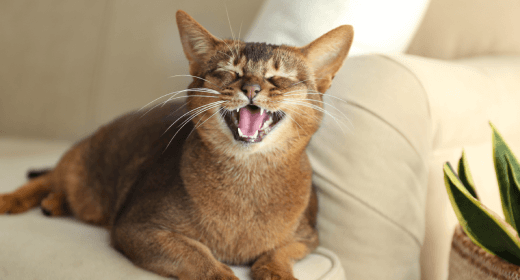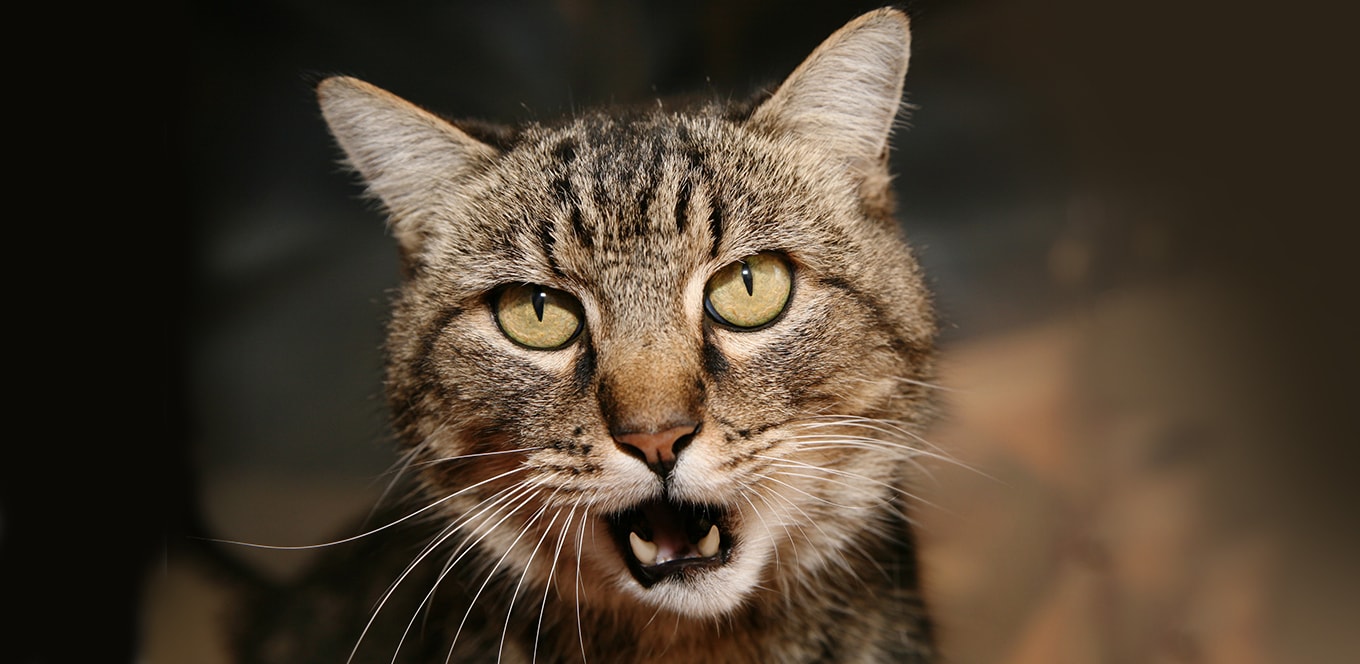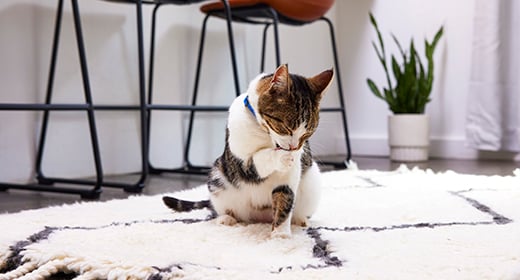

Listen up, Mom or Dad, because your feline definitely has something to say. Cats use more than 100 different vocal sounds to communicate. Here are nine of the most common sounds you’ll hear and what your cat’s unique language means.
While your cat’s purrs are usually a sign that they’re happy, comfortable or content, it’s important to point out that your cat might also purr when they are anxious, agitated or sick — because purring soothes them. The key to figuring out if it’s a “worry purr” is to check if their ears are folded back, if they seem tense or if they just aren’t acting normal. (If that’s the case, call the vet and grab the cat carrier.)
Why do cats meow? It’s simple: It’s their way of communicating with us!
Meows are your cat’s most common “word,” and every one means something different. For example, your cat might meow to greet you when you come home, to ask you to open your bedroom door so they can curl up on your pillow, or to say, “I’d like some more tasty kibble or a second serving of IAMS® PERFECT PORTIONS™ paté, s’il vous plaît.”
Chirps and trills are the loving language of cat mothers. Chirps, or chirrups, are staccato, bird-like sounds mother cats use to say to their kittens, “Follow me.” Trills are higher-pitched chirps your cat uses to say hello or “Pay attention to me.” When your cat directs these sounds at you, chances are they want you to give them some love or follow them somewhere, usually to their food or water bowl. (Shocker, LOL.)
If you have more than one feline fur baby, listen closely. You’ll likely hear your cats talk to each other with these sounds.
When your kitty spies an unsuspecting bird or squirrel frolicking outside the window, they might make a chattering sound at it. This distinctive, repetitive clicking noise is caused by a combination of lip smacking and your cat rapidly vibrating their lower jaw. This odd behavior looks like teeth chattering, and a lot of cats also chirp when they chatter.
This clickety sound is thought to be a mix of predatory excitement and frustration at not being able to get to the elusive feathered or furry prize. Some animal behaviorists even think the sound mimics a fatal bite used to break the bones of their prey. Who knew your li’l feline was so ferocious?!
Regardless of the exact reason cats chatter or chirp at birds and other small animals, most feline parents find it fascinating and amusing to watch.
The unmistakable sound of a cat hissing is like a steak hitting a hot skillet, and it can only mean one thing: Your cat feels threatened and will put up a fight if they have to. Just as important as the hissing sound, however, is the cat body language that comes with it. Your cat will flatten their ears, arch their back, puff their fur, twitch their tail and usually open their mouth to flash their fangs — aka the classic defensive pose.
In addition to a hiss, if your cat makes a deep, guttural growlsound, they’re saying, “Back off.” Similar to a dog’s growl, this noise means your cat is annoyed, scared or angry. Some cats even make short, higher-pitched snarl sounds before launching into a full-blown growl.
While these sounds usually signify an unhappy cat, it’s important to note that some cats growl because they’re in pain from an injury or a health problem. If you suspect this is the case, a trip to the vet is in order.
If your feline snarls or growls at you for any reason, though, it’s best to leave your feisty friend alone.
A yowl, or howl, is a long, drawn-out meow that almost sounds like moaning; it’s your cat’s way of telling you they’re worried or distressed, or that they need you. They might have gotten locked in a closet, can’t find you anywhere or, heaven forbid, have discovered their food bowl is empty. Your cat might also yowl when they don’t feel well or when a new neighborhood cat trespasses on their turf.
Whatever the reason, make sure you immediately help your cat whenever you hear a yowl. Trust us — you’ll both be glad you did.



New cat parents often are unaware of the FVRCP vaccine and why it is essential to get their cats vaccinated for it. FVRCP vaccine stands for Feline Viral Rhinotracheitis, Calicivirus, and Panleukopenia, and it is one of the core vaccines recommended for all cats. Feline rhinotracheitis is an infection that causes flu-like symptoms in cats. While this infection is common in outdoor cats, it can find its way to indoor cats as well. Calicivirus develops mouth ulcers and inflammation while panleukopenia attacks the cat’s immune system, putting its life in lethal danger. Hence, protecting your indoor kitty from these harmful viruses is essential for maintaining their overall health.
That’s where the FVRCP vaccine for kittens and cats comes into picture. It protects our feline creatures from three life-threatening viruses – feline viral rhinotracheitis, calicivirus, and panleukopenia. But before you get your fur baby vaccinated, let’s take a look at some important information about FVRCP vaccines for cats.
Although we know the FVRCP vaccine is crucial for a cat’s well-being, it is also necessary to know when and how to get your kitty inoculated with this combination vaccine. Given below are some essential details related to the FVRCP vaccine for cats that every cat parent should know about:
FVR is caused by the FVH-1 virus. It is one of the most fatal infections that a cat can contract. The FVRCP vaccine is a core vaccine for preventing rhinotracheitis in cats. Feline viral rhinotracheitis is a highly infectious illness that causes symptoms ranging from sneezes and conjunctivitis to fever and lethargy. It spreads through bodily fluids like saliva as well as eyes and nose discharge of infected cats. If not detected and treated in time, FVR in cats can prove fatal. The FVRCP vaccine will ensure that your pet develops immunity against feline rhinotracheitis.
Like feline rhinotracheitis, feline calicivirus (FCV) is another deadly virus in cats. This virus typically attacks the cat’s respiratory tract and oral organs. Calicivirus symptoms can range from upper respiratory tract diseases to mouth ulcers and inflammations. If you observe any signs of calicivirus in your indoor cat, take it to the vet immediate as you should start medication at the earliest. However, it is always better to keep such daunting health issues at bay through vaccination, and the FVRCP vaccine acts as an effective preventive measure.
Abbreviated as FPV, feline panleukopenia is a highly contagious virus that attacks the immune system of cats. It presents symptoms like fever, vomiting, and anorexia. Unlike feline viral rhinotracheitis, which causes flu-like symptoms or calicivirus which causes mouth ulcers and eye infections, FPV attacks the bone marrow and the lymph nodes. And this further decreases the white blood cell count in cats. With FVRCP vaccination, you can prepare your purrfect pal to combat this deadly virus.
Core vaccines are a must for all cats as they equip our feline creatures to fight off some of the most infectious and fatal viruses. FVRCP vaccine is one such core preventive measure besides anti-rabies vaccine for cats. FVR, FCV, and FPV are some of the most contagious viruses that easily spread through the body fluids of infected animals. Vaccinating your kitty with FVRCP enables its body to prepare antigens against these fatal viruses. Hence, FVRCP is said to be one of the core vaccines for cats.
Kittens are inoculated with the FVRCP vaccine every three to four weeks between the ages of 16 to 20 weeks. Booster shots are needed to ensure that the cat’s immune system is completely ready to recognise the vaccine components. These jabs also ascertain that the kitten's immunity is strong enough to combat these four deadly viruses as they age. The kitty should receive a final dose of FVRCP after it turns a year old. Post this, you should revaccinate your feline friend every three years to keep its immunity intact. Please note, the FVRCP vaccine cost depends on the brand you choose to inoculate your pet.
However, before scheduling an appointment for FVRCP vaccination, you must ask the following questions to your veterinarian.
What are the side effects of FVRCP and how soon do they wear off?
How to care for the kitty post-vaccination?
How many booster shots will the kitty need based on its lifestyle, age, and breed?
FVRCP vaccine cost.
The FVRCP vaccine might cause some discomfort and minor side effects. While minor symptoms are common, it is best to visit the veterinarian if you notice any extreme signs of discomfort. Given below are a few of the most common side effects of this vaccine.
Redness or swelling at the injected site
Low-grade fever
Low appetite
Some cats might develop an allergic reaction to the FVRCP vaccine. If you notice your kitty vomiting, itching, or suffering from diarrhea, you must consult the doctor at the earliest.